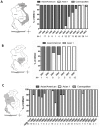Emergence of the Asian 1 genotype of dengue virus serotype 2 in viet nam: in vivo fitness advantage and lineage replacement in South-East Asia
- PMID: 20651932
- PMCID: PMC2907417
- DOI: 10.1371/journal.pntd.0000757
Emergence of the Asian 1 genotype of dengue virus serotype 2 in viet nam: in vivo fitness advantage and lineage replacement in South-East Asia
Abstract
A better description of the extent and structure of genetic diversity in dengue virus (DENV) in endemic settings is central to its eventual control. To this end we determined the complete coding region sequence of 187 DENV-2 genomes and 68 E genes from viruses sampled from Vietnamese patients between 1995 and 2009. Strikingly, an episode of genotype replacement was observed, with Asian 1 lineage viruses entirely displacing the previously dominant Asian/American lineage viruses. This genotype replacement event also seems to have occurred within DENV-2 in Thailand and Cambodia, suggestive of a major difference in viral fitness. To determine the cause of this major evolutionary event we compared both the infectivity of the Asian 1 and Asian/American genotypes in mosquitoes and their viraemia levels in humans. Although there was little difference in infectivity in mosquitoes, we observed significantly higher plasma viraemia levels in paediatric patients infected with Asian 1 lineage viruses relative to Asian/American viruses, a phenotype that is predicted to result in a higher probability of human-to-mosquito transmission. These results provide a mechanistic basis to a marked change in the genetic structure of DENV-2 and more broadly underscore that an understanding of DENV evolutionary dynamics can inform the development of vaccines and anti-viral drugs.
Conflict of interest statement
The authors have declared that no competing interests exist.
Figures





References
-
- Paediatric Dengue Vaccine Initiative. Global burden of Dengue 2009.
-
- Nisalak A, Endy TP, Nimmannitya S, Kalayanarooj S, Thisayakorn U, et al. Serotype-specific dengue virus circulation and dengue disease in Bangkok, Thailand from 1973 to 1999. Am J Trop Med Hyg. 2003;68:191–202. - PubMed
-
- Twiddy SS, Pybus OG, Holmes EC. Comparative population dynamics of mosquito-borne flaviviruses. Infect Genet Evol. 2003;3:87–95. - PubMed
-
- Sittisombut N, Sistayanarain A, Cardosa MJ, Salminen M, Damrongdachakul S, et al. Possible occurrence of a genetic bottleneck in dengue serotype 2 viruses between the 1980 and 1987 epidemic seasons in Bangkok, Thailand. Am J Trop Med Hyg. 1997;57:100–108. - PubMed
-
- Wittke V, Robb TE, Thu HM, Nisalak A, Nimmannitya S, et al. Extinction and rapid emergence of strains of dengue 3 virus during an interepidemic period. Virology. 2002;301:148–156. - PubMed
Publication types
MeSH terms
Substances
Grants and funding
LinkOut - more resources
Full Text Sources
Other Literature Sources
Medical

